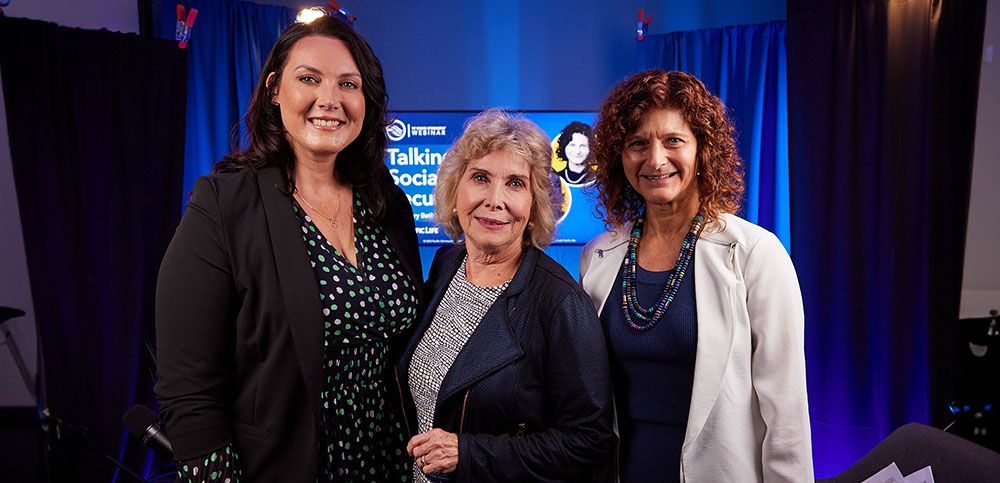Discover financial solutions that protect your future and provide peace of mind. Whether you're exploring annuities, life insurance, or understanding employee benefits through your workplace, Pacific Life offers resources and products designed to meet your personal and family goals.
Support your workforce with innovative employee benefits and retirement solutions. Pacific Life partners with business owners, benefits administrators, and pension fund managers to create customized programs that attract and retain top talent while securing their financial future.
Simplify complex retirement and pension risk management with our tailored solutions for large organizations. Pacific Life specializes in working with institutions to address their unique challenges, offering expertise in pension de-risking and strategic retirement planning for a more secure future.
Empower your clients with confidence by leveraging Pacific Life’s comprehensive portfolio of financial products. From annuities to life insurance, we provide the tools, resources, and support to help financial advisors and brokers deliver exceptional value and long-term results.
-
Individuals
Discover financial solutions that protect your future and provide peace of mind. Whether you're exploring annuities, life insurance, or understanding employee benefits through your workplace, Pacific Life offers resources and products designed to meet your personal and family goals.
-
Employers
Support your workforce with innovative employee benefits and retirement solutions. Pacific Life partners with business owners, benefits administrators, and pension fund managers to create customized programs that attract and retain top talent while securing their financial future.
-
Institutions
Simplify complex retirement and pension risk management with our tailored solutions for large organizations. Pacific Life specializes in working with institutions to address their unique challenges, offering expertise in pension de-risking and strategic retirement planning for a more secure future.
-
Financial Professionals & Brokers
Empower your clients with confidence by leveraging Pacific Life’s comprehensive portfolio of financial products. From annuities to life insurance, we provide the tools, resources, and support to help financial advisors and brokers deliver exceptional value and long-term results.
Top Takeaways
- Many retirees have questions about the more than 2,700 rules for claiming Social Security retirement benefits.
- Several strategies can help retirees increase their benefits after they’ve begun taking monthly payments.
- Staying aware of current regulations set by the Social Security Administration can help retirees receive the full benefits they deserve.
- Mistakes can be costly, but they also can be easily avoided if retirees are armed with the right knowledge.
Social Security retirement benefits are vital parts to most retirees’ lifetime-income plans, but the complexity of the claiming process often leaves clients mystified. Luckily, there are many resources to help them regain their bearings.
On this episode of The Wave Strength, host Caroline Elrod talks with Pacific Life’s Ruth Schau and renowned Certified Financial Planner, Social Security savant, and public speaker, Mary Beth Franklin, about little-known tips for claiming and maximizing Social Security retirement benefits.
Opportunities to Increase Income—Even after Claiming
It’s not unusual for seniors to misunderstand what determines their Social Security retirement benefit amounts. One might choose to begin taking Social Security payments at his or her full retirement age (FRA) or earlier, mistakenly believing that their benefits will increase automatically when they reach their FRA or grow older. It’s important for those approaching retirement age to understand that the decision to take reduced benefits earlier is a fixed one: The benefit won’t increase after payments begin.
However, there are a few ways for retirees to adapt or even reverse the decision to claim benefits if they regret the decision.
- Keep working after claiming. “Benefits are based on my top 35 years of lifetime earnings,” Mary Beth says. “If my current earnings are bigger than one of the years that was previously used in that calculation, now they're going to use this current year and they will automatically increase my future benefits—even if I'm already collecting and even if I'm already beyond full retirement age. That goes on forever.” Plus, if retirees make enough money to lose their benefits while working, their benefits will continue to increase until they reach their FRAs.
- Withdraw the claim application. “Within the first 12 months of claiming benefits, anybody has the right to say, ‘You know, I've changed my mind and I'd like to withdraw my application for benefits.’” But Franklin urges that retirees should be aware of one catch: “You have to pay back any benefits you have received.”
- Suspend benefits after FRA. A retiree can continue taking payments until his or her FRA and then choose to suspend benefits. They don't have to pay anything back, but the monthly checks they've been receiving stop. What’s helpful about this choice? “Because now my benefits are going to start earning 8% a year between my full retirement age up until age 70,” Mary Beth says. “So, by age 70, I can get a much bigger benefit.” However, it's important to note that survivor benefits max out at the FRA, so waiting until age 70 will not increase benefits for surviving spouses.
Knowing the Rules Can Pay Off
More than 2,700 rules govern Social Security retirement benefits, and even representatives of the Social Security Administration occasionally get it wrong. Though mistakes are never malicious, they can have costly consequences for seniors trying to claim their full benefits. Franklin encourages retirees to be diligent in understanding what they’re entitled to.
“I do encourage consumers, workers, and future beneficiaries to research information on the Social Security website at www.SSA.gov and then print it out. And when you ask questions of that Social Security rep and it doesn't match what you have just printed out, you might be able to say: ‘Could you check on that? That doesn't seem to be correct based on what I read on your website.’” And if they still experience resistance, Franklin encourages retirees to be polite but persistent, take names, and request to speak to a supervisor. Write down the date of the conversation, what his or her name is, the length of the conversation, a callback number, and the basic summary of the conversation. While not typical, it isn’t unheard of for retirees to need to push to receive the benefits they deserve.
Plus, if you find the Social Security Administration made a mistake, you could be entitled to a retroactive benefit. “Normally, the maximum retroactive benefit is six months. But, if you can prove that your underpayment was a result of bad advice, sometimes they can go further back than that.”
Learn From Others’ Mistakes
It’s impossible to predict every potential mistake when preparing to claim retirement benefits, but Schau and Franklin encourage retirees to stay informed of others’ experiences to serve as a guide for their own claiming processes.
For instance, one of Schau’s biggest lessons came from her own father: “My dad made one big mistake. I mean, besides starting early at 62. He also . . . decided he wanted a new checking account and just closed the other checking account. [He] didn't think about having overlapping time to get the Social Security check (direct deposit) moved over.”
Franklin has witnessed similar situations. “Here is a situation where it was a husband and wife: The husband had the bigger benefit, and it was being directly deposited into his account. And when he died, [his wife] immediately closed that account, and that messed up the processing of the survivor benefit for her. So, you need to give things some breathing room to let administrative tasks take some time.”
Financial Professionals Can Help
There’s a lot to keep in mind when planning a Social Security retirement benefit-claiming strategy—but retirees don’t have to do it alone. Financial professionals have spent their careers learning how to navigate the complexities of the industry. As Mary Beth puts it, “People often wait until it's too late, not realizing that the sooner you start, the better off you're going to be. Financial professionals can help you with every aspect, whether you're getting married, buying a home, having children, trying to send children to college, or plan for your own retirement. You've got questions, they've got answers.”
About Mary Beth Franklin
As a financial journalist with more than 40 years of experience and a Certified Financial Planner designation, Mary Beth writes about big-picture policy issues, such as the federal budget, tax legislation, and consumer-focused personal finance advice with a focus on Social Security. She has received numerous awards for her publications, and her work has been widely praised for helping both consumers and financial professionals build solid retirement-income plans.
About Ruth Schau
As Senior Director of Pension Solutions, Institutional Division at Pacific Life, Ruth works with companies and their advisors to customize strategies that help address the financial risks inherent in pension plans. Her focus is with organizations who sponsor defined contribution (DC) plans, such as 401(k) or 403 (b) plans, to provide guaranteed lifetime income options for plan participants.
READ MORE
Insurance products can be issued in all states, except New York, by Pacific Life Insurance Company and in all states by Pacific Life & Annuity Company. Product/material availability and features may vary by state. No bank guarantee • Not a deposit • May lose value |
Pacific Life is a product provider. It is not a fiduciary and therefore does not give advice or make recommendations regarding insurance or investment products.
Pacific Life refers to Pacific Life Insurance Company and its subsidiary Pacific Life & Annuity Company. Insurance products can be issued in all states, except New York, by Pacific Life Insurance Company and in all states by Pacific Life & Annuity Company. Product/material availability and features may vary by state. Each insurance company is solely responsible for the financial obligations accruing under the products it issues.
The home office for Pacific Life & Annuity Company is located in Phoenix, Arizona. The home office for Pacific Life Insurance Company is located in Omaha, Nebraska.
VLQ3326-0224W

























































